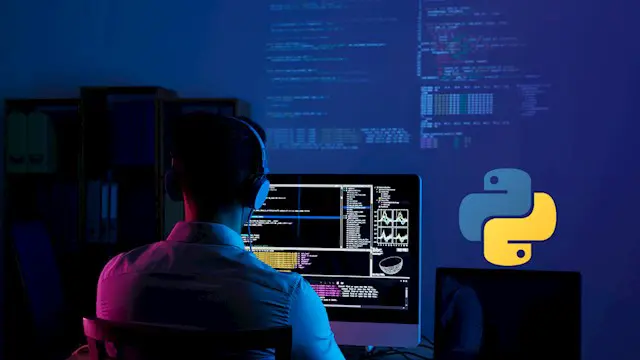
Numerical Computing in Python with NumPy
Self-paced videos, Lifetime access, Study material, Certification prep, Technical support, Course Completion Certificate
Uplatz
Summary
- Reed courses certificate of completion - Free
- Uplatz Certificate of Completion - Free
- Tutor is available to students
Add to basket or enquire
Overview
Uplatz offers this comprehensive course on Numerical Computing in Python with NumPy. It is a self-paced video course consisting of recorded lectures. You will be awarded Course Completion Certificate at the end of the course.
Python is a popular object-oriented programming language that is simple to learn and use. It can operate on a variety of operating systems, including Windows, Linux, and Mac, making it a popular choice in the Data Analytics field. You may work in the Data Science, Machine Learning, Building real-world applications with Python, Big Data Hadoop environment, AI applications, and analytics after completing this Advanced Python Programming course.
NumPy is a fundamental library for numerical computing in Python. It stands for "Numerical Python" and provides support for large, multi-dimensional arrays and matrices, along with a collection of mathematical functions to operate on these arrays. NumPy forms the foundation for many other Python data science libraries and is a core tool for scientific computing and data analysis.
Key features of NumPy:
N-dimensional Arrays: NumPy provides an array object called ndarray, which is a multi-dimensional container for homogenous data. These arrays can be 1-dimensional, 2-dimensional, or even more dimensions, and they allow efficient storage and manipulation of large datasets.
Array Operations: NumPy supports a wide range of element-wise array operations, making it easy to perform mathematical and logical operations on entire arrays without the need for explicit loops. This feature, known as vectorization, results in faster and more concise code.
Broadcasting: NumPy allows broadcasting, which is a mechanism to perform operations on arrays of different shapes. It automatically extends the smaller array to match the shape of the larger array, making it possible to perform element-wise operations on arrays of different dimensions.
Mathematical Functions: NumPy provides a vast collection of mathematical functions for array computations, including basic arithmetic, trigonometric, logarithmic, statistical, and linear algebra functions.
Integration with Other Libraries: NumPy integrates seamlessly with other data science and numerical computing libraries in Python, such as SciPy, Matplotlib, and pandas, creating a powerful ecosystem for data analysis, visualization, and scientific computing.
Curriculum
Course media
Description
Numerical Computing in Python with NumPy - Course Syllabus
Module 1: Getting Started with NumPy
- Introduction to NumPy and its features
- Installing NumPy and setting up the Python environment
- NumPy arrays: Creating, indexing, and slicing arrays
- Broadcasting: Understanding how NumPy handles array shapes
- Basic array operations: Arithmetic, aggregation, and element-wise functions
Module 2: Working with Multi-dimensional Arrays
- Multi-dimensional arrays and their properties
- Array reshaping and stacking
- Universal functions (ufuncs): Applying functions element-wise
- Array broadcasting: Understanding how broadcasting works
- Masked arrays: Handling missing or invalid data
Module 3: Advanced NumPy Operations
- Array manipulation: Concatenation, splitting, and resizing arrays
- Advanced array indexing and slicing techniques
- Fancy indexing: Selecting specific elements or subsets from arrays
- Linear algebra operations with NumPy: Dot products, matrix operations
- Statistical computing with NumPy: Mean, median, variance, and more
Module 4: Data Processing and Visualization with NumPy
- Reading and writing data using NumPy
- Introduction to NumPy's subpackage 'numpy.random'
- Simulation and sampling using random numbers
- Vectorized computation: Benefits of using NumPy over loops
- Basic data visualization with NumPy and Matplotlib
Who is this course for?
Everyone
Requirements
Passion and determination to achieve your goals!
Career path
- Python Developer
- Lead Python Developer
- Data Scientist
- Machine Learning Engineer
- Python Developer API AWS
- Web Developer - Python
- Data Engineer - Python, Spark, Pyspark, Data/ETL Pipelines, Git
- Python Developer - Technologist
- Cloud Engineer - Go/Python
- Data Analyst
- Data Engineer
- Senior Software Engineer (MongoDB/Python)
- Embedded Python Developer
- DevOps Engineer
- DevOps CI/CD Automation Engineer
Questions and answers
Currently there are no Q&As for this course. Be the first to ask a question.
Certificates
Reed courses certificate of completion
Digital certificate - Included
Will be downloadable when all lectures have been completed
Uplatz Certificate of Completion
Digital certificate - Included
Course Completion Certificate by Uplatz
Reviews
Currently there are no reviews for this course. Be the first to leave a review.
Legal information
This course is advertised on reed.co.uk by the Course Provider, whose terms and conditions apply. Purchases are made directly from the Course Provider, and as such, content and materials are supplied by the Course Provider directly. Reed is acting as agent and not reseller in relation to this course. Reed's only responsibility is to facilitate your payment for the course. It is your responsibility to review and agree to the Course Provider's terms and conditions and satisfy yourself as to the suitability of the course you intend to purchase. Reed will not have any responsibility for the content of the course and/or associated materials.


